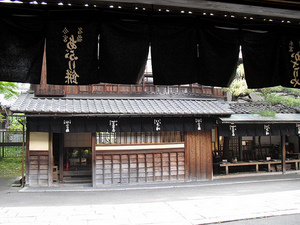Difference between revisions of "Ichiwa"
| Line 1: | Line 1: | ||
[[Image:Aburiya.jpg|right|thumb|300px|View of Kasuragi aburi-[[mochi]] shop as seen from inside aburi-mochi shop Ichiwa.]] | [[Image:Aburiya.jpg|right|thumb|300px|View of Kasuragi aburi-[[mochi]] shop as seen from inside aburi-mochi shop Ichiwa.]] | ||
| − | *'' | + | *''Other Names'': いち和 ''(Ichiwa)'' |
| + | *''Japanese'': 一文字屋和輔 ''(Ichimonjiya wasuke)'' | ||
| − | Ichiwa is an aburi-[[mochi]] shop just outside [[Imamiya Shrine]] in northern [[Kyoto]], which has been in operation continually since the [[Heian period]]. The current building is roughly 300 years old. The shop was run until recently by a Mrs. Hasegawa who passed on the shop to her daughter, the 24th-generation owner of the establishment. | + | Ichimonjiya Wasuke, or Ichiwa for short, is an aburi-[[mochi]] shop just outside [[Imamiya Shrine]] in northern [[Kyoto]], which has been in operation continually since the [[Heian period]]. The current building is roughly 300 years old. The shop was run until recently by a Mrs. Hasegawa who passed on the shop to her daughter, the 24th-generation owner of the establishment. |
The shop consists of a number of benches and stools gathered around small tables, on a sort of covered porch, open on one side to the street. Other seats can be found inside, or in the back, looking out over a garden said to have been designed in the 17th century by [[Kobori Enshu|Kobori Enshû]]. The chief specialty at Ichiwa is aburi-mochi, pieces of mochi (pounded rice) skewered and grilled over charcoal, then doused in a sweet [[miso]] sauce. Aburi-mochi, along with ''[[sekihan]]'' (rice with [[azuki|red beans]]), are associated with the Yasurai Festival, dating back to the 9th century and celebrated at Imamiya Shrine on the first Sunday of April; these two sweets are said to help stave off disease. | The shop consists of a number of benches and stools gathered around small tables, on a sort of covered porch, open on one side to the street. Other seats can be found inside, or in the back, looking out over a garden said to have been designed in the 17th century by [[Kobori Enshu|Kobori Enshû]]. The chief specialty at Ichiwa is aburi-mochi, pieces of mochi (pounded rice) skewered and grilled over charcoal, then doused in a sweet [[miso]] sauce. Aburi-mochi, along with ''[[sekihan]]'' (rice with [[azuki|red beans]]), are associated with the Yasurai Festival, dating back to the 9th century and celebrated at Imamiya Shrine on the first Sunday of April; these two sweets are said to help stave off disease. | ||
| Line 13: | Line 14: | ||
==External Links== | ==External Links== | ||
*[http://maps.google.com/maps?q=%E4%BA%AC%E9%83%BD%E5%B8%82%E5%8C%97%E5%8C%BA%E7%B4%AB%E9%87%8E%E4%BB%8A%E5%AE%AE%E7%94%BA%EF%BC%96%EF%BC%99&ie=UTF8&ll=35.045321,135.742838&spn=0.001192,0.001183&oe=utf-8&client=firefox-a&hnear=Japan,+Ky%C5%8Dto-fu,+Ky%C5%8Dto-shi,+Kita-ku,+Murasakino+Imamiyach%C5%8D,+%EF%BC%96%EF%BC%99&gl=us&t=h&z=19 Ichiwa at Google Maps]. 京都市北区紫野今宮町69. | *[http://maps.google.com/maps?q=%E4%BA%AC%E9%83%BD%E5%B8%82%E5%8C%97%E5%8C%BA%E7%B4%AB%E9%87%8E%E4%BB%8A%E5%AE%AE%E7%94%BA%EF%BC%96%EF%BC%99&ie=UTF8&ll=35.045321,135.742838&spn=0.001192,0.001183&oe=utf-8&client=firefox-a&hnear=Japan,+Ky%C5%8Dto-fu,+Ky%C5%8Dto-shi,+Kita-ku,+Murasakino+Imamiyach%C5%8D,+%EF%BC%96%EF%BC%99&gl=us&t=h&z=19 Ichiwa at Google Maps]. 京都市北区紫野今宮町69. | ||
| + | *[https://www.facebook.com/pages/%E3%81%82%E3%81%B6%E3%82%8A%E9%A4%85-%E4%B8%80%E5%92%8C%E4%B8%80%E6%96%87%E5%AD%97%E5%B1%8B%E5%92%8C%E8%BC%94/128558460613033 Ichiwa on Facebook] | ||
| + | *[https://plus.google.com/100703138349895273226/about?gl=jp&hl=en Ichiwa on Google Plus] | ||
[[Category:Historic Buildings]] | [[Category:Historic Buildings]] | ||
Latest revision as of 15:44, 17 August 2013

- Other Names: いち和 (Ichiwa)
- Japanese: 一文字屋和輔 (Ichimonjiya wasuke)
Ichimonjiya Wasuke, or Ichiwa for short, is an aburi-mochi shop just outside Imamiya Shrine in northern Kyoto, which has been in operation continually since the Heian period. The current building is roughly 300 years old. The shop was run until recently by a Mrs. Hasegawa who passed on the shop to her daughter, the 24th-generation owner of the establishment.
The shop consists of a number of benches and stools gathered around small tables, on a sort of covered porch, open on one side to the street. Other seats can be found inside, or in the back, looking out over a garden said to have been designed in the 17th century by Kobori Enshû. The chief specialty at Ichiwa is aburi-mochi, pieces of mochi (pounded rice) skewered and grilled over charcoal, then doused in a sweet miso sauce. Aburi-mochi, along with sekihan (rice with red beans), are associated with the Yasurai Festival, dating back to the 9th century and celebrated at Imamiya Shrine on the first Sunday of April; these two sweets are said to help stave off disease.
Ichiwa faces another aburi-mochi shop across a narrow pedestrian path just outside the main entrance to Imamiya Shrine. That other shop, Kasuragi, also has a long history, but unlike Ichiwa, which claims to have an unbroken line of family ownership going back about 1000 years, Kasuragi changed hands about two hundred years ago.
References
- Durston, Diane. Old Kyoto. Kodansha International, 2005. pp179-180.
External Links
- Ichiwa at Google Maps. 京都市北区紫野今宮町69.
- Ichiwa on Facebook
- Ichiwa on Google Plus